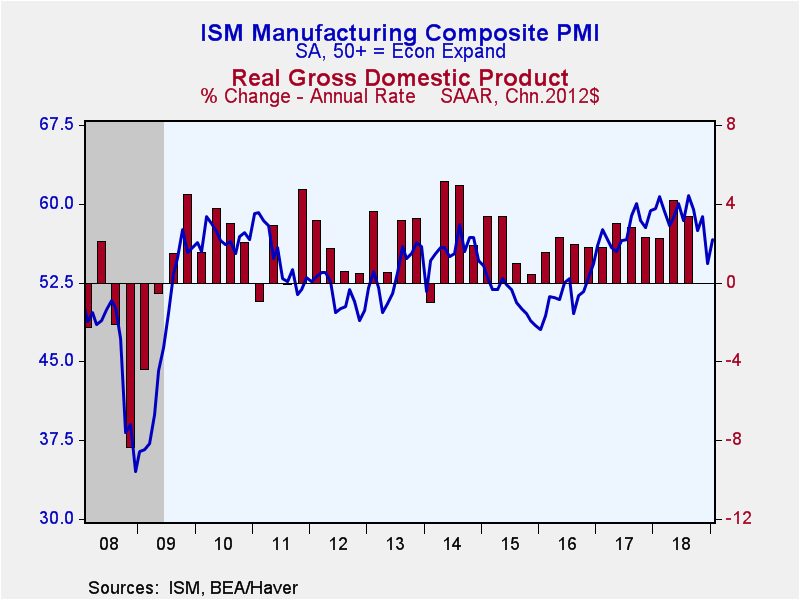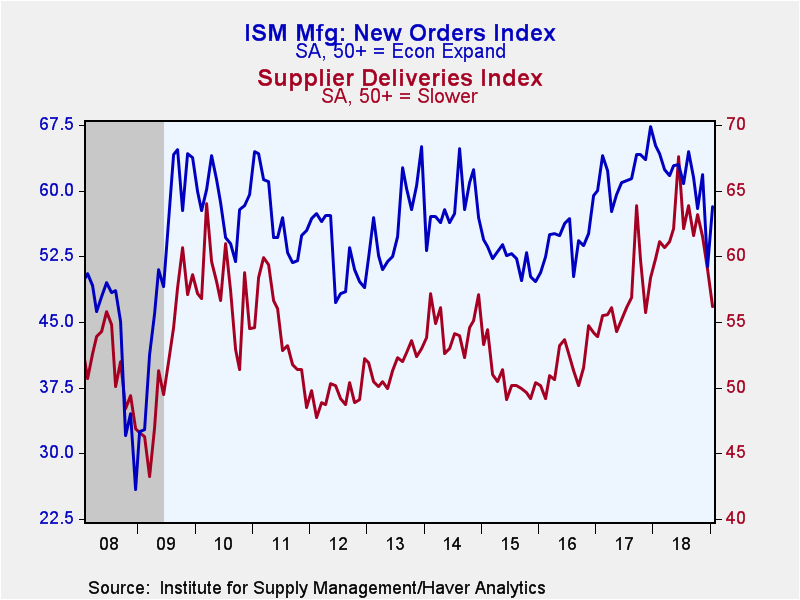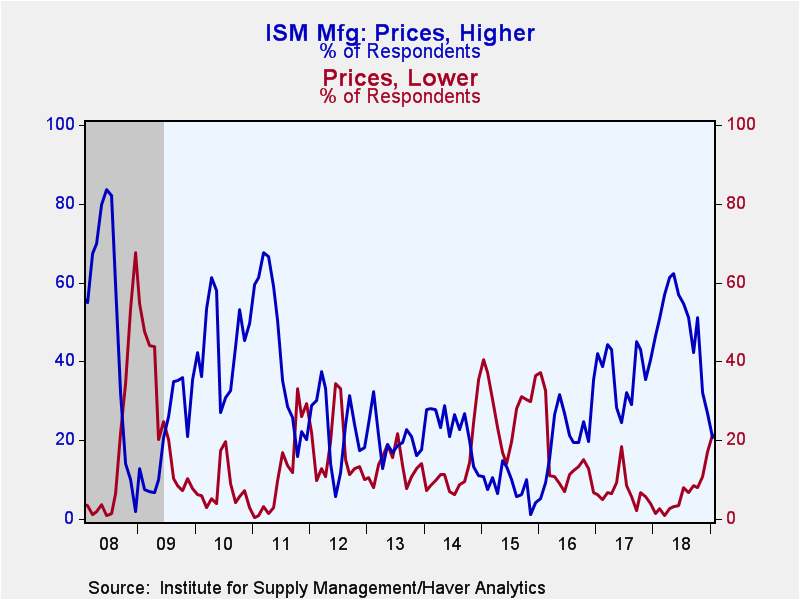 Global| Feb 01 2019
Global| Feb 01 2019ISM Factory Sector Index Rebounded in January
by:Sandy Batten
|in:Economy in Brief
Summary
After having collapsed 4.5 points in December to 54.3 (the lowest reading since December 2016), the ISM manufacturing index rebounded to 56.6 in January. Expectations were for a further decline to 54.1. Still, the January reading [...]
After having collapsed 4.5 points in December to 54.3 (the lowest reading since December 2016), the ISM manufacturing index rebounded to 56.6 in January. Expectations were for a further decline to 54.1. Still, the January reading remains well below the 2018 average of 58.8 (but that was the highest full-year reading since 2004), though it was in line with the 2018 Q4 average of 56.9. Over the past eleven years, there has been a 73% correlation between the index level and q/q growth in real GDP. According to the ISM press release, the January reading is consistent with real GDP growth of around 4%.
The most encouraging part of the January report was the strong rebound in both new orders and production. The new orders index jumped up to 58.2 in January after having collapsed to 51.3 in December but still below its 61.8 reading in November. The production index bounced up to 60.5 in January from 54.1 in December, more than offsetting the December plunge from 59.9 in November.
Less positive were declines in the both the employment and the supplier deliveries index. The employment index eased to 55.5, its second consecutive monthly decline, and seemed to comport with the subpar 13,000 increase in manufacturing payrolls in today's employment report. The supplier deliveries index fell sharply to 56.2, its third consecutive monthly decline and indicating the fastest pace of order fulfillment since November 2017.
Meanwhile, inflation pressures continued to ease notably. The prices paid index slumped to a sub-50 reading of 49.6 in January, its first sub-50 reading since February 2016 and most likely reflecting the continued decline in energy prices. Only 20.6% of respondents reported paying higher prices in January, the lowest percentage since November 2016, while 21.5% reported paying lower prices, the highest percentage since February 2016. Reflecting ongoing trade tensions, the new export order index slipped to 51.8 in January, its lowest reading since November 2016
The ISM figures are diffusion indexes where a reading above 50 indicates expansion. The figures from the Institute for Supply Management can be found in Haver's USECON database; further detail is found in the SURVEYS database. The expectations number is available in Haver's AS1REPNA database.
| ISM Mfg (SA) | Jan | Dec | Nov | Jan'18 | 2018 | 2017 | 2016 |
|---|---|---|---|---|---|---|---|
| Headline Index | 56.6 | 54.3 | 58.8 | 59.6 | 58.8 | 57.4 | 51.4 |
| New Orders | 58.2 | 51.3 | 61.8 | 65.2 | 61.5 | 62.2 | 54.5 |
| Production | 60.5 | 54.1 | 59.9 | 65.5 | 60.7 | 61.0 | 53.8 |
| Employment | 55.5 | 56.0 | 57.7 | 55.2 | 56.9 | 56.8 | 49.2 |
| Supplier Deliveries | 56.2 | 59.0 | 61.5 | 59.8 | 62.0 | 56.8 | 51.8 |
| Inventories | 52.8 | 51.2 | 52.9 | 52.3 | 52.9 | 50.4 | 47.5 |
| Prices Paid Index (NSA) | 49.6 | 54.9 | 60.7 | 72.7 | 71.7 | 65.0 | 53.1 |
Sandy Batten
AuthorMore in Author Profile »Sandy Batten has more than 30 years of experience analyzing industrial economies and financial markets and a wide range of experience across the financial services sector, government, and academia. Before joining Haver Analytics, Sandy was a Vice President and Senior Economist at Citibank; Senior Credit Market Analyst at CDC Investment Management, Managing Director at Bear Stearns, and Executive Director at JPMorgan. In 2008, Sandy was named the most accurate US forecaster by the National Association for Business Economics. He is a member of the New York Forecasters Club, NABE, and the American Economic Association. Prior to his time in the financial services sector, Sandy was a Research Officer at the Federal Reserve Bank of St. Louis, Senior Staff Economist on the President’s Council of Economic Advisors, Deputy Assistant Secretary for Economic Policy at the US Treasury, and Economist at the International Monetary Fund. Sandy has taught economics at St. Louis University, Denison University, and Muskingun College. He has published numerous peer-reviewed articles in a wide range of academic publications. He has a B.A. in economics from the University of Richmond and a M.A. and Ph.D. in economics from The Ohio State University.










